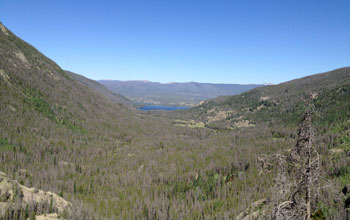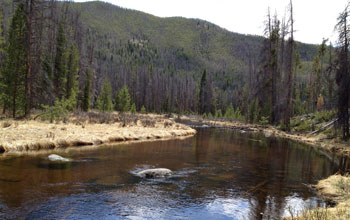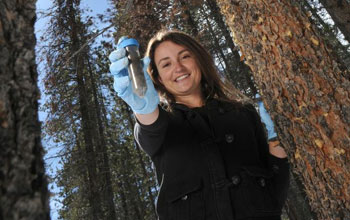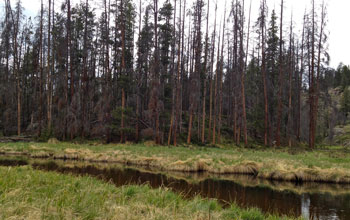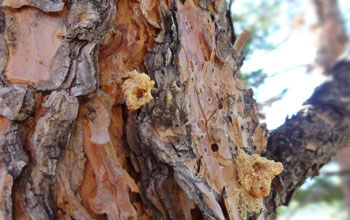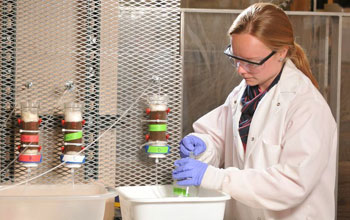Researcher also engages educators and students in an open forum.
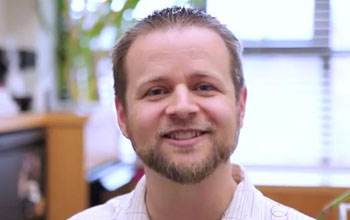 |
| Christopher Marx teaches organismic and evolutionary biology at Harvard University. Credit: Christopher J. Marx, Harvard University |
 |
| These vials contain frozen evolved populations. Credit: Christopher J. Marx, Harvard University |
How do organisms adapt over time? Do they evolve through a series of
small beneficial steps as envisioned by Charles Darwin, or through a
series of rare but large jumps? Or through a combination of both?
For
example, "did a giraffe's neck get longer because there were thousands
of mutations each resulting in a millimeter increase?" asks Christopher
Marx, associate professor of organismic and evolutionary biology at
Harvard University. "Or were there three or four changes over time that
changed the size of the vertebrae dramatically?"
Marx's research
focuses on adaptation, the process by which populations improve in
their ability to grow and survive. "One of the major questions that we
are trying to address is: What is the relative proportion of small
beneficial mutations to big beneficial mutations?" he says. "And how
does this outcome differ with the size of the population?"
Understanding
how adaptation works in smaller populations is important because many
scenarios--from new infections to cancer--involve small numbers of
cells.
"Many current therapeutic approaches aim to reduce
population sizes of pathogens in order to thwart their eventual
success," Marx says. "This would work very well if these shrunken
populations struggle to find beneficial mutations, but would be much
less effective if big benefit mutations--to the pathogen or cancer--are
actually fairly easy to achieve."
Until recently, many scientists
held the classic Darwinian view that adaptation occurs gradually
through a series of small changes, he says. Furthermore, they believed
that it is extremely rare that a random mutation would actually benefit
an organism in a given environment, he says.
"One consequence of
the rarity of beneficial mutations would be that any improvement that
arose would have a chance to take over before another beneficial
mutation would arise, and would thus proceed unchallenged," Marx says.
"This would lead to a series of rare, step-like jumps in performance. It
would also mean that the mutations that won--rising to 100 percent of
the population--would give a fairly clear picture of what is
biologically possible for that organism."
In order to study
adaptation, including how organisms can improve, Marx's laboratory grows
hundreds of bacterial populations in the laboratory. Scientists can
preserve live bacteria in an ultra-cold freezer, allowing them to revive
and directly study their common ancestor, the one they used to initiate
succeeding generations over time.
"Despite the diminutive
physical size of these populations, each of which were grown in 1/50th
of an ounce of liquid, the final population size could reach as high as
100 million cells," Marx says.
Recent work from a number of
laboratories, including Marx's, has shown that beneficial mutations
actually can occur much more readily than previously thought. "This
changes adaptation dramatically because many innovations can arise at
once and they cannot all win," he says.
He compares this
competition between rival genetic innovations to what happens in a
market economy when, for example, a new field opens and "many companies
enter the race and, over time, the better ones beat out the weaker
ones," he says.
"Because of the potential for having many new
inventions present at once, the population size itself has a profound
effect on adaptation," he adds. "The intuition has been that really
amazing solutions to a problem are much less common than mediocre ones.
Thus, the current theory is that small populations improve via little
steps and big populations take big steps."
Marx is conducting his
research under a National Science Foundation (NSF) Faculty Early Career
Development (CAREER) award, which he received in 2009 as part of NSF's
American Recovery and Reinvestment Act. The award supports junior
faculty who exemplify the role of teacher-scholars through outstanding
research, excellent education and the integration of education and
research within the context of the mission of their organization. NSF is
funding his work with $702,452 over five years.
The educational component of his grant
includes a project-based lab course built around experimental
evolution, and a website where scientists who work in microbial
evolution can freely share educational materials.
Specifically, Marx has been studying Methylobacterium,
a common microbe that lives on the surface of leaves and eats such
things as methanol. "It's also the main cause of that pink scum in your
shower," he says.
Based upon ongoing work evolving Methylobacterium in the laboratory, Marx and his graduate student, Nigel Delaney, have both confirmed and begun to question current beliefs.
"If
you change the population size, three things are supposed to happen,"
he says. "The first is that big populations should adapt faster than
small ones, which turns out to be true. The second is that big
populations should have more infighting than little populations, which
is also true. The third is that big populations will move by big steps,
and small populations will move by small steps."
Their work is
ongoing; however, their current data suggest that the third point might
not necessarily be true. "Our small and big populations both took big
steps," he says. "Big mutations can happen easily. We've seen that in
our bug, and it completely changes the picture."
The experiments
conducted by Marx and others using populations of microbes in the
laboratory that they can control allows them to learn about the range of
adaptation possibilities in a way that is difficult when directly
studying infectious diseases or cancer, where there will be confounding
differences in environments, starting strains or host genetics, and
medical treatments.
"The recent use of sequencing to discover
cancer variants within a polyp, for example, has re-discovered what
researchers in the lab had already shown: many beneficial mutants tend
to rise simultaneously, rather than sequentially," he says.
Marx's
lab also has begun to examine the outcome of combining more than one
beneficial mutation. "Do they stay equally valuable?" he says.
Last year, in a paper his team published in the journal Science,
they reported on a general trend of diminishing returns. "It turns out
that beneficial mutations become less valuable when combined with each
other," he says.
Similarly, a University of Houston group led by
Marx's friend and colleague, Tim Cooper, an assistant professor of
biology, found this identical trend in the evolution of Escherichia coli.
"We
had given presentations right after each other at a conference the year
before and were shocked by the similarity in our work," Marx says.
"That the same trend emerged in two very different systems hinted that
it might be a much more widespread finding. Indeed, later papers with
viruses and yeast have seen the same."
Ultimately, Marx and Cooper
decided to submit their papers at the same time, because "unlike the
mutations we studied, we felt our work was more valuable when combined."
| -- | Marlene Cimons, National Science Foundation |
Investigators
Christopher Marx
Related Institutions/Organizations
Harvard University
Related Awards
#0612591 Adaptation, Tradeoffs and Specialized Metabolism in Experimental and Natural Populations
#0845893 CAREER: Distribution of fitness effects, identity and interaction of beneficial mutations available for adaptation
#0845893 CAREER: Distribution of fitness effects, identity and interaction of beneficial mutations available for adaptation
Total Grants
$752,447
Related Websites
MicrobialEvolution.org:
MicrobialEvolution.org:
http://www.microbialevolution.org/
Organismic Evolutionary Biology with Christopher Marx:
Organismic Evolutionary Biology with Christopher Marx:
The National Science Foundation.-
Guillermo Gonzalo Sánchez Achutegui
ayabaca@gmail.com
ayabaca@hotmail.com
ayabaca@yahoo.com
Inscríbete en el Foro del blog y participa : A Vuelo De Un Quinde - El Foro!









